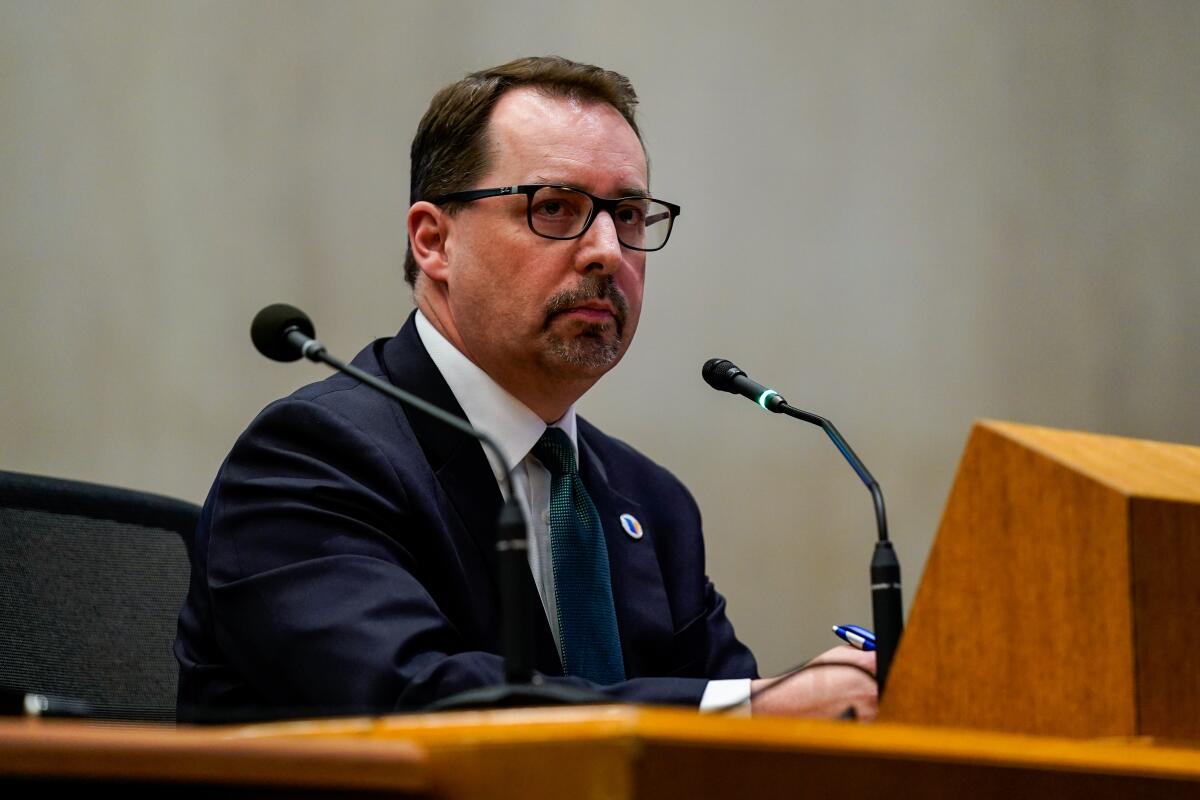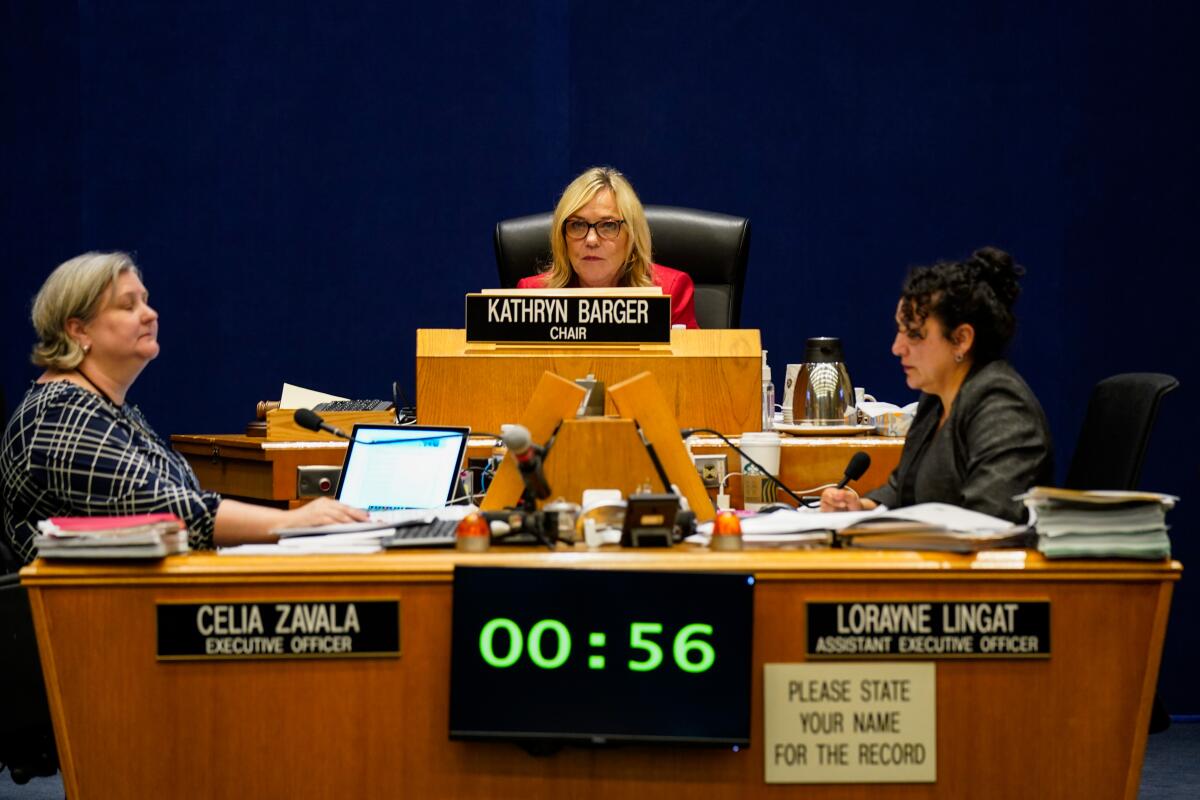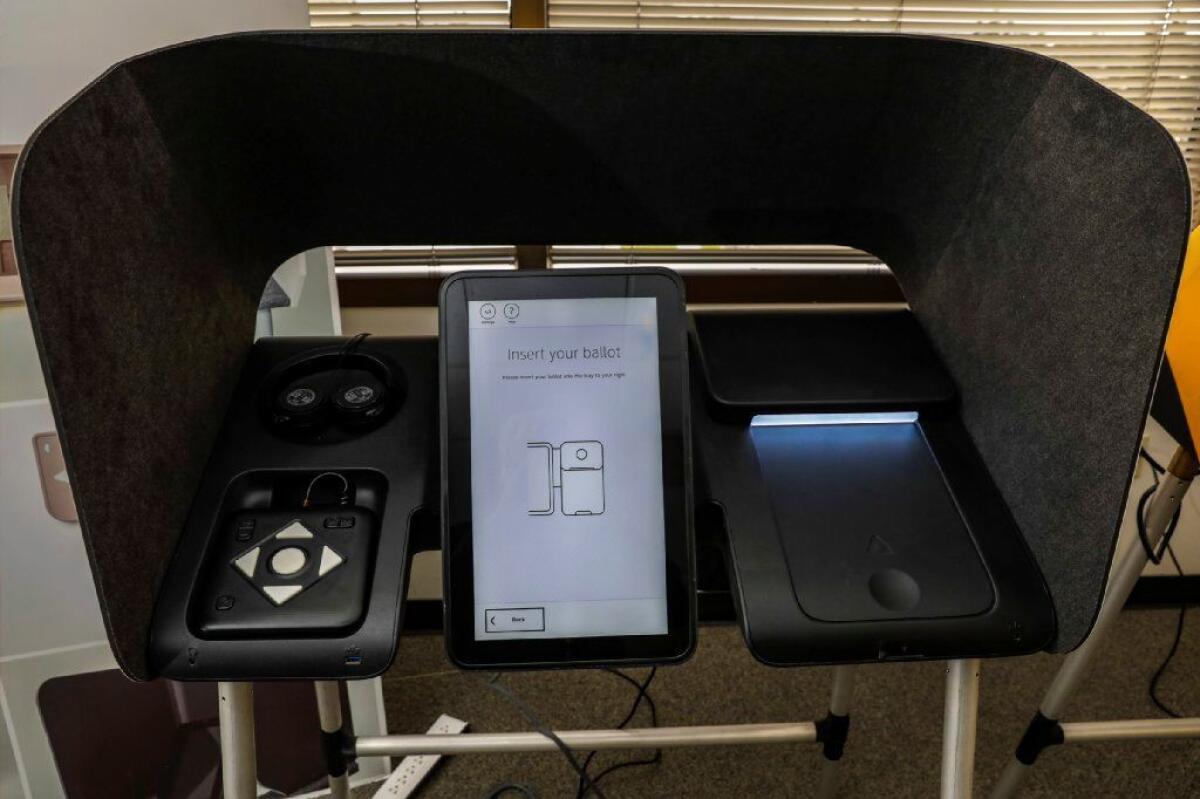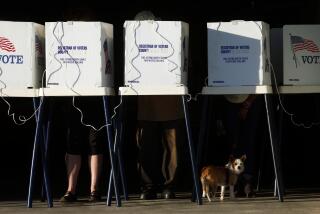Long lines, voting problems prompt an investigation, grilling of L.A.’s elections chief

- Share via
The Los Angeles County Board of Supervisors has ordered an investigation into complaints about long waits and equipment malfunctions that hampered voting at many poll centers during last week’s primary election.
At a hearing on Tuesday, the supervisors ordered the county’s chief elections official, Dean Logan, to explain what they called “serious problems” for voters — and to address them before the general election in November.
They didn’t mince words in telling Logan that they were dissatisfied and concerned with the performance of a new $300-million electronic voting system that his office unveiled for the primary.
“We made it less accessible for people on election day. We made it less convenient. We made it less desirable to vote,” said Supervisor Janice Hahn, whose motion prompted the hearing. “I’m sorry to say I’ve lost confidence, and I know the public has lost confidence. We have to fix this.”
Logan, who, in his more than a decade on the job, has weathered controversies without such a public rebuke from the supervisors, apologized for the problems that voters experienced, but stood by his long-developed vision for a new voting system.
“I hear you, and I hear the voices of our voters and of our poll workers. It was not the implementation we were hoping for. I regret that and I apologize,” Logan said. “I also accept and take seriously my responsibility for addressing these issues.”
The new system, approved by Secretary of State Alex Padilla’s office and partly prompted by changes in California law, overhauled the voting experience in L.A. County, scrapping traditional precinct polling locations in favor of fewer but more flexible vote centers.

The county also adopted new electronic polling rosters, allowing election workers to print customized ballots regardless of the voting location, and new custom-built ballot-marking devices intended to make casting a ballot easier and more accessible.
Taken together, the overhaul was intended to allow more voters to cast ballots earlier, either at any of the nearly 1,000 vote centers, or by mail. But a considerable number of voters still decided on an in-person experience, exacerbating delays amid technical and staffing hurdles.
Logan on Tuesday acknowledged there were technical glitches that led to frustration and delays, but also cited problems with the locations of some of the vote centers, which were too small to handle the crush of voters.
“I don’t think the answer is to give up on this,” he added. “I think the answer is to get it right.”
The supervisors voted unanimously to investigate the “serious problems” some voters encountered.
In their motion, the supervisors raised concerns about excessive wait times and issues checking in at the polls, and whether vote centers were adequately staffed and had enough working equipment.
“It really is critical to know the quality of our voting devices,” said Supervisor Hilda Solis, who also called for more foreign language support among poll workers.
The supervisors also questioned why 17,000 voters didn’t receive their requested mail ballots on time — and why some of those ballots mistakenly excluded a question on Measure FD, which would have granted more funding to the county’s Fire Department.

Their motion calls on Logan, working with state election officials, to report back to the board within 45 days on “corrective measures” to ensure similar problems don’t occur in November when many more people are likely to vote.
The county’s chief executive officer also has been ordered to hire an independent consultant to review the problems and to “validate” any action plan presented by Logan’s office.
On Monday, Logan’s office released a list of voting centers and the total number of ballot-marking devices and voter-lookup machines deployed to each. The data on the list reveal wide discrepancies in the capacity at centers across the county.
The vote centers had, on average, about 20 ballot-marking devices. But more than 140 had only five machines — potentially one source of bottlenecks reported by voters on primary day.
Logan has said his office also may have overestimated how many voters would use the extended period to cast their ballots early.
In the 2016 June primary election, for example, there were 4,500 precincts and polling places at 2,800 schools, churches and other quasi-public facilities around the county.
Last week’s primary election included just 970 vote centers, though those locations remained open for as long as 11 days to reduce the crush of voters. Yet only about 250,000 of an estimated 2.1 million ballots were cast early by voters who came to the centers.
Both new computer systems experienced problems on the day of the primary, and voters also complained about the machines and poll books failing or general confusion about both.
Mitch Paradise, a writer and substitute teacher who voted at Brockton Elementary in Los Angeles, said a diagram about how to use the new voting machine was misleading. He said he almost failed to cast his ballot properly because he forgot to select a final button.
“That is a diagram for disenfranchisement,” he said of the instructions. “If you put that thing in there and don’t push the button, you have not voted.”
But despite the seemingly widespread problems reported by voters and elections officials and observed by The Times, a new survey suggests that many voters left the process having a positive experience with the system.
An exit poll by Loyola Marymount University of 3,500 voters at 50 randomly selected vote centers found that nearly 90% of voters said their experience was “excellent” or “good.” And about 75% of the respondents said the new voting technology was “much easier” or a “bit easier” compared to previous elections.
The poll also found, however, that roughly 20% said they spent at least 20 minutes or more at a vote center.
“This whole narrative that the vote center model didn’t work, or that it was unsuccessful, or that everybody was waiting in these ridiculously long lines just wasn’t true,” said Brianne Gilbert, associate director at the Center for the Study of Los Angeles. “We’re certainly not saying that everything was perfect — there’s room for improvement — but overall, things were successful.”
However, the poll, which was conducted by student researchers, did little to quell the concerns of supervisors.
“We have a lot of work to do,” said Supervisor Kathryn Barger. “Between now and November we have to restore confidence, so that people know we take this seriously, and that it’s not going to happen again.”
Tuesday’s hearing comes as Logan’s office continues tabulating mail and provisional ballots from the March 3 primary election ahead of the official certification scheduled for March 27. As of Tuesday, some 493,000 votes remained uncounted — down from 675,000 on Friday.
Logan’s office stressed that the process of confirming and counting late-arriving ballots is unrelated to the delays experienced on election day. The lengthy tabulation schedule had been anticipated.
Many vote-by-mail ballots, for example, were cast at vote centers, drop boxes and by mail on election day. Those ballots require signature verification and preparation prior to tabulation, Logan has said.
Also, thousands of ballots were filed provisionally or under the condition that a voter registration be reviewed.
Key among the outstanding contests is the contest for district attorney, in which incumbent Jackie Lacey is seeking to avoid a runoff election.
The outcome of the hotly contested 2nd District supervisor’s race also hadn’t yet been settled, in which L.A. City Council member Herb Wesson and state Sen. Holly Mitchell appeared to be headed to a runoff, while currently leading over former City Council member Jan Perry.
More to Read
Sign up for Essential California
The most important California stories and recommendations in your inbox every morning.
You may occasionally receive promotional content from the Los Angeles Times.










